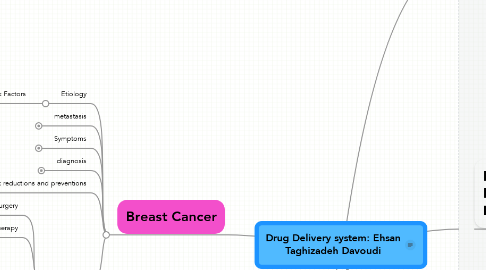
1. Drug Absorption
1.1. Immediate release
1.2. Delayed release
1.3. Extended release or sustained release
1.3.1. methods Preparation
1.3.1.1. Enteric coatings
1.3.1.2. Diffusion controlled (Reservoir devices, monolithic device)
1.3.1.3. water penetrating controlled (Osmotic system, swelling system)
1.3.1.4. Hydrophilic component
1.3.1.5. Polymeric colloidal particles
1.3.2. Mechanisms
1.3.2.1. Swelling
1.3.2.2. Diffusion
1.3.2.3. Degradation
1.3.3. Different type of sustain released form in stomach
1.3.3.1. Floating dosage form
1.3.3.1.1. Effervescent Floating Dosage Form
1.3.3.1.2. Non-Effervescent Floating Dosage Form
1.3.3.2. Mucoadhesive dosage form
1.3.3.2.1. Hydrogel
1.3.3.2.2. Hydrophil
2. Breast Cancer
2.1. Etiology
2.1.1. Risk Factors
2.1.1.1. increasing age
2.1.1.2. family history
2.1.1.3. infertility
2.1.1.4. first pregnancy above the age of 30
2.1.1.5. previous treatment of breast cancer
2.1.1.6. confirmed biopsy of benign breast cancer
2.1.1.7. breast radiation therapy
2.1.1.8. BRCA 1,2 or 3
2.1.1.9. alcohol users
2.1.1.10. diet full of red meat
2.1.1.11. late menopause
2.1.1.12. non-lactation
2.1.1.13. obesity after menopause
2.2. metastasis
2.2.1. Bone (70%)
2.2.2. Soft tissue
2.2.3. Lung (60-74%)
2.2.4. Liver (5%)
2.2.5. Brain (10-15%)
2.3. Symptoms
2.3.1. Breast Tumor
2.3.2. Painless lump
2.3.3. nipple discharge
2.3.4. change in breast skin
2.3.5. changes in the nipple (Paget disease )
2.3.6. inflation of auxiliary lymph nodes
2.3.7. changing in breast size
2.3.8. one-sided inflation of the arm or an upper organ
2.3.9. invasion to other organs (Metastases)
2.4. diagnosis
2.4.1. Mammography
2.4.2. Ductography
2.4.3. Sonography
2.5. Risk reductions and preventions
2.6. Treatments
2.6.1. Surgery
2.6.2. Radiotherapy
2.6.3. Drug
2.6.3.1. Chemotherapy
2.6.3.2. Hormonal therapy
2.6.3.3. List of Drugs
2.6.3.3.1. Drugs Used to Prevent Breast Cancer
2.6.3.3.2. Drug Combinations Used in Breast Cancer
2.6.3.3.3. Drugs Used to Treat Breast Cancer
3. Capecitabine
3.1. Mechanism
3.2. Bioactivities and pharmacokinetics
3.3. Indication and usage
3.4. Side Effect
3.5. Clinical studies
3.5.1. Phase 1
3.5.2. Phase 2
3.5.3. Phase 3
4. Preparation and Characterization of Gastric Floating Dosage Form of Capecitabine and Investigation its In-vitro and In-vivo effects
4.1. Preparation of sustained release form of Capecitabine
4.2. Determination of floating lag time and total floating time
4.3. Tablet hardness
4.4. Tablet friability
4.5. Preparation of standard curve
4.6. Uniformity Drug content in tablets
4.7. Tablet weight Uniformity
4.8. In vitro release study
4.9. Comparison of the prepared formulation with commercial brand in term of drug release
4.10. Fourier transform infrared spectroscopy (FTIR)
4.11. X-ray Diffraction (XRD)
4.12. Spectrophotometry (Ultraviolet, UV)
4.13. Differential Scanning Calorimetry(DSC)
4.14. Stability test
4.15. Investigation the effect of prepared formulation on the cell lines
4.16. In Vivo study
4.16.1. In vivo floating study (imaging study)
4.16.2. In vivo drug release study
5. Type of Tablet
5.1. Compressed tablets
5.2. Multiply compressed tablets
5.3. Sugar coated tablets
5.4. Film coated tablets
5.5. Gelatin coated tablets
5.6. Enteric coated tablets
5.7. Buccal and sublingual tablets
5.8. Chewable tablets
5.9. Effervescent tablets
5.10. Molded tablets
5.11. Triturates tablet
5.12. Hypodermic tablets
5.13. Dispensing tablets
5.14. Immediate release tablets
5.15. Extended release tablets
5.16. Instantly disintegrating or dissolving tablets
5.17. Vaginal tablets
6. Tablet Preparation
6.1. Wet Granulation
6.2. Dry Granulation
6.3. Direct Compression
7. Type of Dosage form
7.1. Oral
7.1.1. Tablets, Capsules Magmas, Gels, Powder, Buccal, Lozenge, Pastilles, Dental, Pill, Granules and Liquid
7.2. Sublingual
7.2.1. Tablets, Troches, lozenges, Drops
7.3. Parenteral
7.3.1. Solutions, Suspensions, Intravenous injection, Intramuscular injection, Subcutaneous injection, Intradermal, Intracardiac, Intraocular, Intrathecal, Intra articular, Epidural
7.4. Epicutaneous
7.4.1. Ointments
7.5. transdermal
7.5.1. Gels, Creams, Infusion pumps, Pastes, Plasters, Powders, Aerosols, Lotions, Transdermal patches, discs, Solutions
7.6. Conjunctival
7.6.1. Contact lens inserts, Ointments
7.7. Intraocular, Intra-aural
7.7.1. Solutions, Suspensions
7.8. Intranasal
7.8.1. Solutions, Sprays, Inhalants, Ointments
7.9. Intrarespiratory
7.9.1. Aerosols, Nebulizer or (atomizer), Inhaler
7.10. Rectal
7.10.1. Solutions, Ointments, Suppositories, Gels, Enema
7.11. Vaginal
7.11.1. Solutions, Ointments, Emulsion foams, Gels, Tablets, Inserts, suppositories, sponge, Pessary, Vaginal ring, Douche, Intrauterine device
7.12. Urethral
7.12.1. Solutions, Suppositories
7.13. Tropical
7.13.1. Ointments, Creams, Gels (Jellies), Dusting powders, Transdermal patch, Plasters, Liniments, Lotions, Collodion, Paints, Pressurized dispensers (aerosol sprays), Paste
7.14. Otic
7.14.1. Ear drops
